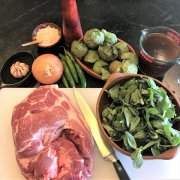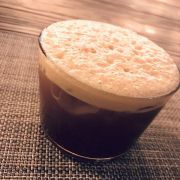Tinga de Pollo Tostadas
Tinga de Pollo Tostadas
Servings: 6
Ingredients
For cooking the chicken
- 2 boneless, skinless chicken breasts
- 2 cloves of garlic, smashed
- 2 whole cloves
- 1 bay leaf
For the Sauce
- 3 medium tomatoes If you use canned tomatoes, omit the blackening step.
- 3 chipotle peppers in adobo Adjust the chipotles for more or less heat.
- 1/2 C chicken stock
- 4 cloves of garlic minced
- 2 tsp ground cumin
- 1/2 tsp nutmeg
- 2 tbsp vegetable oil
- 2 white onions, halved and sliced thinly
- 1/2 lb pork chorizo
- 1 head of iceberg lettuce, shredded Retain 1 cup of the lettuce for topping
- Salt and pepper to taste
To Serve
- Corn Tostadas
- Cotija Cheese, crumbled
Instructions
Mise en Place
- Measure out spices
- Mince garlic and mashed garlic
- Peel and slice onions
- Slice tomatoes in half
Cook
- Place chicken in a saucepan over medium heat covered by 1 inch water. Add smashed garlic, whole cloves, and a bay leaf. Simmer 20-30 minutes until the meat pulls apart easily.
- While the chicken cooks, add tomatoes to a pan over medium-high heat and blacken on all sides, about 6-8 minutes.
- Blend the tomatoes with chipotle peppers, chicken stock, cumin, and nutmeg until smooth.
- In a large skillet, cook onions, minced garlic and chorizo over medium heat until softened and rendered, about 10 minutes.
- While chorizo cooks, remove the cooked chicken from the water and shred with two forks.
- Add the shredded lettuce to the chorizo mixture and saute a few more minutes.
- Add blended tomato sauce and shredded chicken to the skillet and cook stirring until any excess liquid has evaporated, about 10 minutes. Salt and Pepper to taste.
Plate
- Often, refried beans are used as a first layer on the tostadas which adds great flavor and an anchoring base for later ingredients. Either way, pile the tinga onto your tostatas and top with crumbled cotija cheese and remaining shredded lettuce. Other great topping include avocado slices, chopped cilantro, mexican crema, and your favorite salsa. Alternately, Tinga can be served as tacos, in a burrito, on sopes, as a torta... anywhere delicious meat would feel at home.

Notes
 Jamie Kelly is an American marketing professional turned gastronaut. She is eating her way through a full-spectrum exploration of food culture in Spanish-speaking lands and staging ambitious re-enactments of her finds in her own kitchen. To join the expedition, follow at FB: gastro-curious, IG: jamie_gastrocurious and www.gastro-curious.com.
Jamie Kelly is an American marketing professional turned gastronaut. She is eating her way through a full-spectrum exploration of food culture in Spanish-speaking lands and staging ambitious re-enactments of her finds in her own kitchen. To join the expedition, follow at FB: gastro-curious, IG: jamie_gastrocurious and www.gastro-curious.com.










